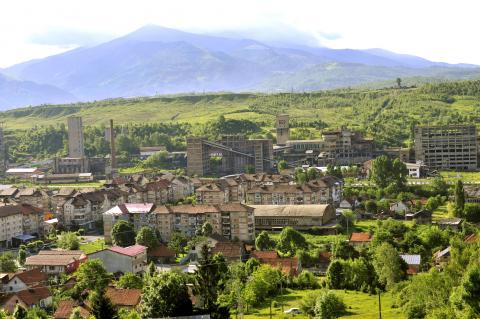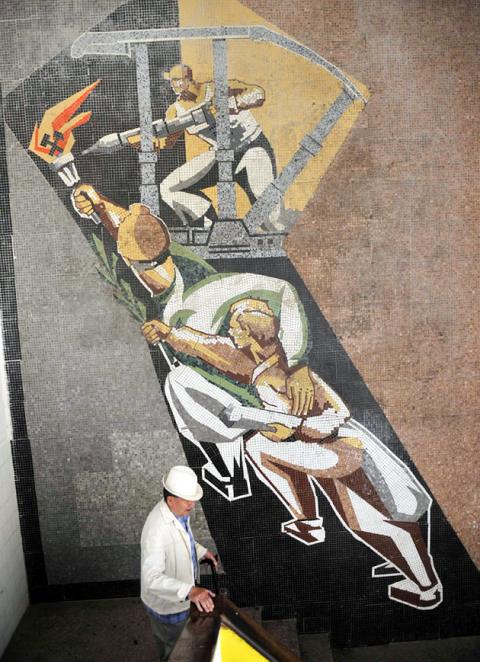At the foot of the majestic Carpathian mountains, Petrila waits in dread for the closure of its coal mine, the oldest in Romania and the life force of a town struggling to survive.
“We are already the valley of tears; we don’t want to become the valley of death,” one resident said, referring to the Jiu Valley where Petrila lies, Romania’s main coal mining region where miners’ numbers have dwindled to only a fraction of those employed in the 1990s.
Petrila’s 153-year-old mine has not only been the town’s livelihood, but its very identity. Petrila without mines would be like Bordeaux without its vineyards or Silicon Valley without its IT firms, locals say.

Photo: AFP
However, pressure from the European Commission, the EU executive, on member governments to cut subsidies to lossmaking mines means the one in Petrila, two elsewhere in Romania and several others across the 27-member bloc will be shut down by 2018. Demolition work has already started.
“It’s the age-old story of the deindustrialization of Europe,” said David Schwartz, a Bucharest director who recently drew attention for Underground, a play he and the well-known Romanian playwright Mihaela Michailov worked on for a year, giving voice to the miners and their families in this once-prosperous company town.
The EU’s plan is to shift subsidies from mines toward renewable energies. Up to 30,000 jobs, out of a total 100,000 in the EU mining sector, could be lost.

Photo: AFP
In Spain, angry miners have staged protests and clashed with police, but those in Romania appear resigned to their fate, still smarting from violent protests in 1990 that many feel stigmatized them wrongly.
That year, then-Romanian president Ion Iliescu called about 10,000 Jiu Valley miners to Bucharest to end protests against his government, the first elected after the fall of the communist regime, but one made up mostly of former communists, like himself.
The miners were severely criticized for using force against protesters, but many today say those who took part were “manipulated.”
Communist-era mosaics at the Petrila mine are a reminder of its flourishing past before the economic decline of the last two decades.
In 1988, the town had about 4,000 miners, now there are 688. In the wider Jiu Valley, numbers have dropped from 50,000 to 7,600, Petrila mine director Constantin Jujan said.
“In 1997, a wave of redundancies at the time meant people suddenly got a lot of money. But they weren’t ready; they spent, they set up businesses and got in debt, found themselves without homes, with nothing,” said local restaurant owner Elena Chelba, whose husband and father are both miners.
Today the unemployment rate in the town is more than 40 percent.
Charity shops proposing second-hand clothes, crockery and toys are testimony to the hard times.
“I don’t know if things can get any worse,” Chelba said. “But if the mine closes, things will not be rosy; so many people depend on it.”
Everyday, ignoring the danger, dozens of locals jump on the trains bringing coal to Petrila to steal a few lumps, either to keep warm or to sell.
One of them, who gave only his first name, Traian, collects what coal he finds on the tracks in red buckets — there is no way his pension of 200 euros (US$244) a month can pay for heating.
Traian’s son has left Romania for Germany, and his daughter will join him for two months of seasonal work. Like many, Traian doesn’t complain for himself, but worries about his children. Emigration is often seen as the only answer.
“My daughter’s future is not here,” one miner said solemnly, tramping out of the mine after a night’s work.
“Some families cannot pay their gas and electricity bills any more. We give them clothes so their children are not ashamed to go to school,” said Florin Popescu, who runs the local branch of Save the Children.
The center ensures that about 100 children get a hot meal, as well as psychological and educational help.
“We know that we will have to leave because there is no work here. It’s sad for me because this is where I have grown up and where my friends are,” said Cristinel Homoc, a 15-year-old who dreams of becoming a soccer player or a lawyer.
Some residents hope for better days in a region that they believe has immense tourism potential.
Stretching about 1,500km across central Europe, the Carpathians are blessed with virgin forest, rich flora and wildlife, including lynx and bears.
Romanian culture is also a draw. A local caricaturist, Ion Barbu, organizes festivals and has turned the childhood home of writer Ion D. Sirbu — a key opposition figure during Nicolae Ceausescu’s dictatorship — into a museum.
Barbu, like many other residents, wants to preserve the buildings at the mine site to create cultural and “industrial” tourism, to retain Petrila’s link with its prouder past.
Industrial tourism has worked in other areas: UNESCO designated three former mining sites in the Wallonia region of southern Belgium and one site in northern France as World Heritage sites.
However, the residents’ dreams have met with opposition from Petrila deputy mayor Constantin Ramascanu, who would prefer to raze the site.
Rejecting all ideas of green tourism — even from Britain’s Prince Charles, who has tried to develop rural tourism in Romania — Ramascanu’s vision is a valley covered in hotels, casinos and quad-biking tracks.

JITTERS: Nexperia has a 20 percent market share for chips powering simpler features such as window controls, and changing supply chains could take years European carmakers are looking into ways to scratch components made with parts from China, spooked by deepening geopolitical spats playing out through chipmaker Nexperia BV and Beijing’s export controls on rare earths. To protect operations from trade ructions, several automakers are pushing major suppliers to find permanent alternatives to Chinese semiconductors, people familiar with the matter said. The industry is considering broader changes to its supply chain to adapt to shifting geopolitics, Europe’s main suppliers lobby CLEPA head Matthias Zink said. “We had some indications already — questions like: ‘How can you supply me without this dependency on China?’” Zink, who also

The number of Taiwanese working in the US rose to a record high of 137,000 last year, driven largely by Taiwan Semiconductor Manufacturing Co’s (TSMC, 台積電) rapid overseas expansion, according to government data released yesterday. A total of 666,000 Taiwanese nationals were employed abroad last year, an increase of 45,000 from 2023 and the highest level since the COVID-19 pandemic, data from the Directorate-General of Budget, Accounting and Statistics (DGBAS) showed. Overseas employment had steadily increased between 2009 and 2019, peaking at 739,000, before plunging to 319,000 in 2021 amid US-China trade tensions, global supply chain shifts, reshoring by Taiwanese companies and

Taiwan Semiconductor Manufacturing Co (TSMC, 台積電) received about NT$147 billion (US$4.71 billion) in subsidies from the US, Japanese, German and Chinese governments over the past two years for its global expansion. Financial data compiled by the world’s largest contract chipmaker showed the company secured NT$4.77 billion in subsidies from the governments in the third quarter, bringing the total for the first three quarters of the year to about NT$71.9 billion. Along with the NT$75.16 billion in financial aid TSMC received last year, the chipmaker obtained NT$147 billion in subsidies in almost two years, the data showed. The subsidies received by its subsidiaries —

OUTLOOK: Pat Gelsinger said he did not expect the heavy AI infrastructure investments by the major cloud service providers to cause an AI bubble to burst soon Building a resilient energy supply chain is crucial for Taiwan to develop artificial intelligence (AI) technology and grow its economy, former Intel Corp chief executive officer Pat Gelsinger said yesterday. Gelsinger, now a general partner at the US venture capital firm Playground Global LLC, was asked at a news conference in Taipei about his views on Taiwan’s hardware development and growing concern over an AI bubble. “Today, the greatest issue in Taiwan isn’t even in the software or in architecture. It is energy,” Gelsinger said. “You are not in the position to have a resilient energy supply chain, and that,